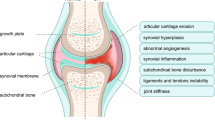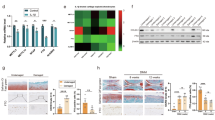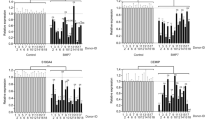Abstract
Osteoarthritis (OA) is the most common joint disease worldwide. Recent studies have shown that targeted disruption of Smad3 in mouse results in OA. To reveal the possible association between the Smad3 gene mutation and human OA, we employed polymerase chain reaction-single strand conformation polymorphism and sequencing to screen mutations in all nine exons of the Smad3 gene in 32 patients with knee OA and 50 patients with only bone fracture. A missense mutation of the Smad3 gene was found in one patient. The single base mutation located in the linker region of the SMAD3 protein was A → T change in the position 2 of codon 197 and resulted in an asparagine to isoleucine amino-acid substitution. The expressions of matrix metalloproteinase 2 (MMP-2) and MMP-9 in sera of the patient carrying the mutation were higher than other OA patients and controls. This is the first report showing that the Smad3 gene mutations could be associated with the pathogenesis of human OA.
Similar content being viewed by others
Log in or create a free account to read this content
Gain free access to this article, as well as selected content from this journal and more on nature.com
or
References
Jordan JM, Kington RS, Lane NE et al: Systemic risk factors for osteoarthritis; In Felson DT (conference chair): Osteoarthritis: new insights. Part 1: The disease and its risk factors. Ann Intern Med 2000; 133: 637–639.
Reginster JY : The prevalence and burden of arthritis. Rheumatology 2002; 41(suppl 1): 3–6.
Zeng Q, Huang S, Xiao Z et al: Osteoarthritis: clinical and epidemiological investigation. Chin J Internl Med 1995; 34: 88–90.
Zhang N, Shi Q, Zhang X et al: Epidemiological investigation of osteoarthritis. Chin J Intern Med 1995; 34: 84–87.
Massague J : TGF-β signal transduction. Annu Rev Biochem 1998; 67: 753–791.
Yang X, Letterio JJ, Chen L et al: Targeted disruption of SMAD3 results in impaired mucosal immunity and diminished T cell responsiveness to TGF-β. EMBO J 1999; 18: 1280–1291.
Yang X, Chen L, Xu L et al: TGF-beta/Smad3 signals repress chondrocyte hypertrophic differentiation and are required for maintaining articular cartilage. Journal of Cell Biology 2001; 153: 35–46.
Arai T, Akiyama Y, Okabe S et al: Genomic structure of the human Smad3 gene and its infrequent alterations in colorectal cancers. Cancer Lett 1998; 122: 157–163.
Kleiner DE, Stetler-Stevenson WG : Quantitative zymography: detection of picogram quantities of gelatinase. Anal Biochem 1994; 218: 325–329.
Tanaka A, Kumagai S, Kawashiri S et al: Expression of matrix metalloproteinase-2 and -9 in synovial fluid of the temporomandibular joint accompanied by anterior disc displacement. J Oral Pathol Med 2001; 30: 59–64.
Yamada Y, Okuizumi H, Miyauchi A et al: Association of transforming growth factor beta1 genotype with spinal osteophytosis in Japanese women. Arthritis Rheum 2000; 43: 452–460.
Micheal W, Yang X, Deng C : Functions of mammalian Smad genes as revealed by targeted gene disruption in mice. Cytokine Growth Factor Rev 2000; 11: 49–58.
Bevan S, Woodford-Richens K, Rozen P et al: Screening SMAD1, SMAD2, SMAD3, and SMAD5 for germline mutations in juvenile polyposis syndrome. Gut 1999; 45: 406–408.
Wang D, Kanuma T, Takama F et al: Mutation analysis of the Smad3 gene in human ovarian cancers. Int J Oncol 1999; 15: 949–953.
Giggins GJ, Kinzler KW, Vogelstein B et al: Frequency of Smad gene mutations in human cancers. Cancer Res 1997; 57: 2578–2580.
Osawa H, Shitara Y, Shoji H et al: Mutational analysis of transforming growth factor β type II receptor, Smad2, Smad3 and Smad4 in esophageal squamous cell carcinoma. Int J Oncol 2000; 17: 723–728.
Kretzschmar M, Doody J, Massague J : Opposing BMP and EGF signaling pathways converge on the TGF-β family mediator Smad1. Nature 1997; 389: 618–622.
Miyazaki Y, Tsukazaki T, Hirota Y et al: Dexamethasone inhibition of TGF beta-induced cell growth and type II collagen mRNA expression through ERK-integrated AP-1 activity in cultured rat articular chondrocytes. Osteoarthritis Cartilage 2000; 8: 378–385.
Wu Y, Feng Y, Yang X et al: TGF-β1 mediated by SMAD3 inhibits the expression of MMP9 in COS7 cells. Chin J Biochem Mol Biol 2002; 18: 684–687.
Acknowledgements
This work was supported by National Science Fund for Distinguished Young Scholars (30025028), National Natural Science Foundation of China (39970413) and Hi-Tech Research and Development Program of China (2001AA216081).
Author information
Authors and Affiliations
Corresponding author
Rights and permissions
About this article
Cite this article
Yao, JY., Wang, Y., An, J. et al. Mutation analysis of the Smad3 gene in human osteoarthritis. Eur J Hum Genet 11, 714–717 (2003). https://doi.org/10.1038/sj.ejhg.5201034
Received:
Revised:
Accepted:
Published:
Issue date:
DOI: https://doi.org/10.1038/sj.ejhg.5201034
Keywords
This article is cited by
-
The polymorphism of SMAD3 rs1065080 is associated with increased risk for knee osteoarthritis
Molecular Biology Reports (2019)
-
Effect of transforming growth factor-β2 on biological regulation of multilayer primary chondrocyte culture
Cell and Tissue Banking (2018)
-
The changing role of TGFβ in healthy, ageing and osteoarthritic joints
Nature Reviews Rheumatology (2017)
-
SMAD3 and SMAD4 have a more dominant role than SMAD2 in TGFβ-induced chondrogenic differentiation of bone marrow-derived mesenchymal stem cells
Scientific Reports (2017)
-
A SMAD3 gene polymorphism is related with osteoarthritis in a Northeast Chinese population
Rheumatology International (2013)



